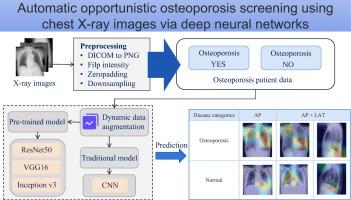Automatic opportunistic osteoporosis screening using chest X-ray images via deep neural networks
IF 3.6
2区 医学
Q2 ENDOCRINOLOGY & METABOLISM
引用次数: 0
Abstract
Background
Osteoporosis is a bone disease characterized by reduced bone mineral density and quality, which increases the risk of fragility fractures. The current diagnostic gold standard, dual-energy X-ray absorptiometry (DXA), faces limitations such as low equipment penetration, high testing costs, and radiation exposure, restricting its feasibility as a screening tool.
Method
To address these limitations, we retrospectively collected data from 1995 patients who visited Chongqing Daping Hospital between January 2019 and August 2024. We have developed an opportunistic screening method using chest X-rays and designed three innovative deep neural network models using transfer learning: Inception v3, VGG16, and ResNet50. These models were evaluated for their classification performance of osteoporosis using chest X-ray images and validated through an external dataset.
Results
The ResNet50 model demonstrated superior performance, achieving average accuracies of 87.85 % and 90.38 % in the internal test dataset across two experiments, with AUC values of 0.945 and 0.957, respectively. These results outperformed traditional convolutional neural networks. In the external validation, the ResNet50 model achieved an AUC of 0.904, accuracy of 89 %, sensitivity of 90 %, and specificity of 88.57 %, demonstrating strong generalization ability. And the model shows robust performance despite concurrent pulmonary pathologies.
Conclusions
This study provides an automatic screening method for osteoporosis using chest X-rays, without additional radiation exposure or cost. The ResNet50 model's high performance supports clinicians in the early identification and treatment of osteoporosis patients.

基于深度神经网络的胸部x线图像自动机会性骨质疏松症筛查。
背景:骨质疏松症是一种骨病,其特征是骨矿物质密度和质量降低,这增加了脆性骨折的风险。目前的诊断金标准双能x射线吸收仪(DXA)面临设备渗透率低、测试成本高、辐射暴露等局限性,限制了其作为筛查工具的可行性。方法:为了解决这些局限性,我们回顾性收集了2019年1月至2024年8月在重庆市大坪医院就诊的1995例患者的资料。我们开发了一种利用胸部x光进行机会性筛查的方法。此外,我们使用迁移学习设计了三个创新的深度神经网络模型:Inception v3、VGG16和ResNet50。通过胸部x线图像评估这些模型对骨质疏松症的分类性能,并通过多中心数据进行外部验证。结果:ResNet50模型表现出优异的性能,在内部测试数据集中,两次实验的平均准确率分别为87.85 %和90.38 %,AUC值分别为0.945和0.957。这些结果优于传统的卷积神经网络。在外部验证中,ResNet50模型的AUC为0.904,准确率为89 %,灵敏度为90 %,特异性为88.57 %,具有较强的泛化能力。该模型在并发肺部病变的情况下表现出稳健的性能。结论:本研究提供了一种使用胸部x线自动筛查骨质疏松症的方法,无需额外的辐射暴露或费用。ResNet50模型的高性能支持临床医生早期识别和治疗骨质疏松症患者。
本文章由计算机程序翻译,如有差异,请以英文原文为准。
求助全文
约1分钟内获得全文
求助全文
来源期刊

Bone
医学-内分泌学与代谢
CiteScore
8.90
自引率
4.90%
发文量
264
审稿时长
30 days
期刊介绍:
BONE is an interdisciplinary forum for the rapid publication of original articles and reviews on basic, translational, and clinical aspects of bone and mineral metabolism. The Journal also encourages submissions related to interactions of bone with other organ systems, including cartilage, endocrine, muscle, fat, neural, vascular, gastrointestinal, hematopoietic, and immune systems. Particular attention is placed on the application of experimental studies to clinical practice.
 求助内容:
求助内容: 应助结果提醒方式:
应助结果提醒方式:


